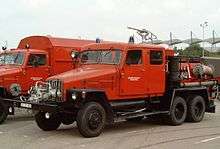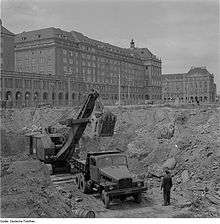IFA G5

The IFA G5 is a three-axle conventional truck developed and produced by IFA in East Germany from 1952 until 1964.
History
It was produced from as a prototype in 1952 until 1964 in VEB Kraftfahrzeugwerk "Ernst Grube" Werdau . The work was part of the IFA and walked out of the 1945 resolution Schumann works in Werdau out. The development of the truck began during World War II in the Vogtland Maschinenfabrik AG (Vomag). Since the Soviet occupation forces completely dissolved Vomag shortly after the end of the war however, they did allow further development at Auto Union or at Horch.
The vehicle was also in East Germany for military use are provided. There was also a variety of additional devices can be attached.
The vehicle could be compared with the triple-axle Soviet ZIS 151.
Technicals


The G5 has the three axles and can be all-wheel driven (6×6), however, the front axle can be switched off (6×4).
- Engine: 6-cylinder diesel engine with 120 hp
- Transmission: 5-speed-change gearbox with dog-type gearbox
- Allowable utility weight: 5 tons
- Maximum speed on road: 80 km / h
- Maximum off-road: 40 km / h
- Models / structures: dump truck, crane, suitcase (including workshop case), Flatbed with tarpaulin, tanker, water cannon, several fire trucks and others. The bodies were fitted out in many cases with other companies in East Germany.
The cab was manufactured in several different versions, such as a closed cab, cab with long cab (crew cabin with fire engines), cab with soft top and a cab with fold-down windshield.
The truck G5 and H6, which were built about the same time in Werdau, exhibit some identical modules. In order to improve the properties, especially for off-road use, equipped with a more powerful engine of advanced G5/3, but this was not built in the original series.
Users


The main customers for these trucks were the Alert police or NVA and the People's Police. Vehicles of Combat Groups of the Working Class were used as water cannon, on 13 August 1961 during the construction of the Berlin Wall.
_W50_Plane.jpg)
There were not present in sufficient quantities in the GDR trucks, decommissioned NVA G5s were later in Agricultural Production Cooperatives and more used in business, for example as a fuel transporter for Minol. The G5 was used by the fire service primarily as a fire engine (TLF 15) with crew cabin.

Goods for army use five tons payload usually sufficient and the important off-road, this corresponded to the needs of the industry only to a small extent. The ratio of costs and benefits did not match the given economic conditions. This meant that the G5 was rarely used with the advent of alternative trucks.
Development
There were two G5 generations; G5/1 and G5/2.
The newly developed from the ground up to be the successor to the G5 G5/3 System. Provided was an air-cooled V8 diesel engine with 150 hp from a displacement of 12.5 litres. The three-axle vehicle in turn should receive single tires with tire pressure control system. In the years 1958/59 and 1961 four functional models and two production prototypes were built. In May 1962 the development of the G5 / 3 has been cancelled. Occasion was the decision for the series production of the W50. However, the reasons for the termination are the former economic situation in the GDR owed. In particular, the engine development and the tires were preparing this problems. Also the necessary in the manufacturing plant in Werdau for series production investments were given the low demand on the part of the NPA and the lack of export opportunities considered too high.
Literature
- Christian Suhr:
- G5 – Der Dreiachser aus Werdau/G5 - The six-wheeler from Werdau, Reichenbach / V. Halle / S. 2007, ISBN 3-938426-04-7 .
- Nutzfahrzeuge aus Werdau/Trucks from Werdau, Klaus Rabe, Willich 2003. ISBN 3-926071-29-X .
- Günther Wappler: Geschichte des Zwickauer und Werdauer Nutzfahrzeugbaues/History of Zwickau and Werdauer Trucks, Verlag Bergstraße, Aue 2002.
- Hartmut Frank Hunter: IFA-Hauber aus Zwickau und Werdau (Feuerwehrarchiv)/IFA Hauber from Zwickau and Werdau (Fire Archive) Verlag Technik, Berlin 1999. ISBN 3-341-01242-7 .
External links
| Wikimedia Commons has media related to IFA G5. |
- G5-Modelle bei der KVP/NVA/G5 models in the Alert Police/NVA
- Wasserwerfer G5 SK-2/Water cannons G5 SK-2
- Einsatzspektrum des G5/Range of applications G5
- Weitere Prototypen aus Werdau/More prototypes from Werdau